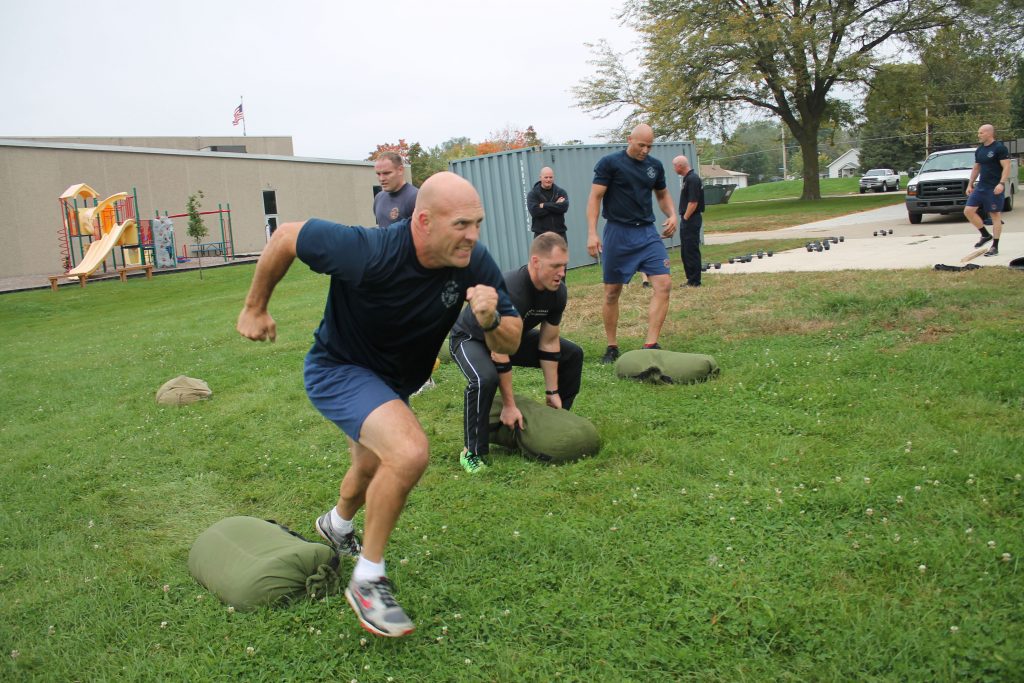
By Rob Shaul
A March 2014 study published in the Journal of Strength and Conditioning Research, “Firefighter Health and Fitness Assessment: A Call to Action” reinforced what I’d previously understood about full-time firefighters.
“Firefighters in the United States have only average physical fitness,” the study reports, “and, of particular concern, have high rates of excess weight and obesity.”
Forty-nine percent of line-of-duty firefighter deaths are caused by heart attacks, not the fire. “Lack of physical fitness and the deconditioning, which lead to overexertion plus unrecognized cardiovascular disease risk factors, are among the prominent contributory risks toward line of duty injuries and deaths.”
I wasn’t surprised by these figures – I had heard this before. What I was surprised by is that 30% of US Fire Departments have wellness and fitness programs, and required, high-jeopardy fitness tests are much more common than in law enforcement.
As well, multiple departments require two types of fitness assessments, a Cooper-Institute inspired, push up, sit up, run test, as well as a job-specific physical ability test. In addition, many departments also require a medical physical which includes a body fat analysis, VO2 max test, resting heart rate, etc.
I wrote a few weeks ago about police departments with high-jeopardy fitness tests and could find just two in the US.
A similar search on fireside side uncovered several departments with required fitness tests.
Below are some of the highlights:
Sun City West, Arizona
- Required annual fitness exam includes FMS screening, body composition, aerobic capacity test, hearing, vision and flexibility testing
- Quarterly fitness assessment including a physical agility test and fitness exam.
- http://www.scwfire.org/index.asp?Type=B_BASIC&SEC=%7BAE2AA797-F832-4E13-B1EB-8A629DB332BE%7D
Westminster, Colorado
- Required annual “Job Specific Performance Assessment” consisting of hose pulling, stair climbing, ladder hauling and a 175-pound dummy drag, in turnout gear
- Required annual Cooper Test – push ups, sit ups, 1.5 mile run, body fat, etc.
- http://www.ci.westminster.co.us/Safety/FireDepartment/AboutUs/TrainingandFitness.aspx
West Metro Fire Rescue, Lakewood, Colorado
- Required annual Physical Ability Test to include tower climb, charged hose drag, equipment hoist, dummy drag, and equipment carry (https://www.youtube.com/watch?v=qbwtNImrkC0)
- Required annual “Wellness Evaluation” which includes a VO2 Max Test, body fat, push ups, sit ups, hand grip
- Required, annual Wildland Fire Aerobic Capacity Test – which is a 400m run for time in a 40-pound weight vest.
– https://www.westmetrofire.org/index.aspx?NID=126
Silver City, New Mexico
- Required, daily training
- Required, monthly fitness test consisting of push ups, sit ups, pull ups and a 1.5 mile run
- Required, annual health assessment
- Required, semi-annual Firefighter Ability Test in bunker gear. Test includes a hose line advance, confined space crawl, loaded tower climb, sledge hammer strikes, and rescue dummy drag
- http://www.townofsilvercity.org/r/town_of_silver_city_NM.php?r=60,6r7s3
Horry County, South Carolina
- Regular daily fitness training
- Annual Job-Related Ability Test which includes a forcible entry task, charged hose drag, equipment carry, stair climb, ceiling hoist, and dummy drag while in bunker gear and while wearing SCBA and on air. (https://www.youtube.com/watch?v=JScnyU_XIyU)
- A separate Job Related Ability Test for engine drivers
- http://www.horrycountyfirerescue.com/portals/4/siteimages/sop/sop-615.pdf
In addition to departments with established fitness programs and assessments, the Dallas Fire-Rescue department has recently implemented its first wellness-fitness evaluation and other departments are considering implementing programs.
In the law enforcement world, union resistance often prevents enlightened leaders from instituting a fitness program and testing. But firefighters also have a strong union presence, but you could argue, have a much stronger culture of fitness than law enforcement. I was surprised.
Part of the reason for the greater attention to fitness in the fire rescue culture could be broader association support. The National Fire Protection Association has developed standards for fire fighter medical testing, and health-related fitness programs. The NFPA has also created the Wellness-Fitness Initiative to promote fitness amongst firefighters.
Does your department have required fitness testing? Does it require on-shift physical training? I’m interested in the details.
Please email details: coach@mtntactical.com
You Might Also Like MTI’s Urban Fire/Rescue Assessment